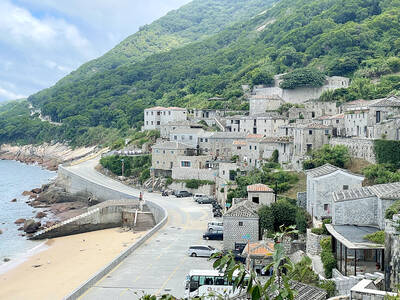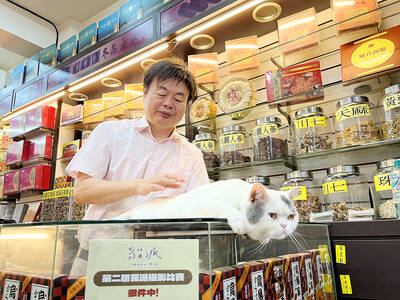The National Kaohsiung Center for the Arts (Weiwuying) is marking another step in its development with a five-night outdoor performance extravaganza that starts on Wednesday next week.
Construction of the Weiwuying center, designed by Dutch architect Francine Houben, was finished four years ago, but the interior work has been underway since then.
The Preparatory Office for the Weiwuying Center for the Arts commissioned Taipei-based Wonders of Art International to create a production to celebrate its development, and the result is The First Seeds, an interactive light sculpture show that combines 3D video mapping projections with live performances and music.

Photo Courtesy of Wonders of Art International
Serina Chen (陳琪), director of Wonders of Art and the Image in Motion Theater Company, which created the multimedia, immersive Window of the City show for the 2010 Shanghai World Expo, on Thursday told a news conference in Taipei that The First Seeds will use 18 projectors to project video onto the exterior of the theater complex that faces the southern lawn of Weiwuying Metropolitan Park (衛武營都會公園).
The projections are to cover an area that is 223m wide and 39m high and includes the open-air theater in the building’s roof, said Chen, who is also the director of The First Seeds.
The show will tell the history of the National Kaohsiung Center for the Arts, which is in an area that served as a military base during the Japanese colonial era and then became a camp for the Eighth Army in the 1950s.
Years of debate over what to do with the site followed the decommissioning of the camp in 1979, before the government in 2003 decided to turn the 47 hectares into a national performance center and a park.
The Kaohsiung City Government in 2006 launched an international architectural competition to select a designer and developer, which was won by Houben’s Mecanoo architects the following year.
Houben’s design was inspired by the banyan trees on the site and Chen said the performance is subtitled "Under the Banyan Trees," as the video projections begin with the flourishing of a single tree that grows into a forest.
The show pays tribute to Kaohsiung’s maritime history, as well as its development into an industrial center and its hope to become a major performance and cultural center, hence the “seed” imagery, Chen said.
The Kaohsiung Children’s Choir, dancer Chang Ya-ting (張雅婷) and 50 other performers are to take part in the show.
There will be three performances of The First Seeds each night, at 7pm, 8pm and 9pm, as well as an interactive art installation created by young artists and students from around Kaohsiung from 5pm to 6:30pm.
While the performances are free, tickets are required to enter the installation area and will be available from information desks set up on the sides of the outdoor theater area.
This story has been updated since it was first published.

The Chinese military has built landing bridge ships designed to expand its amphibious options for a potential assault on Taiwan, but their combat effectiveness is limited due to their high vulnerability, a defense expert said in an analysis published on Monday. Shen Ming-shih (沈明室), a research fellow at the Institute for National Defense and Security Research, said that the deployment of such vessels as part of the Chinese People’s Liberation Army (PLA) Navy’s East Sea Fleet signals a strong focus on Taiwan. However, the ships are highly vulnerable to precision strikes, which means they could be destroyed before they achieve their intended

The first two F-16V Bock 70 jets purchased from the US are expected to arrive in Taiwan around Double Ten National Day, which is on Oct. 10, a military source said yesterday. Of the 66 F-16V Block 70 jets purchased from the US, the first completed production in March, the source said, adding that since then three jets have been produced per month. Although there were reports of engine defects, the issue has been resolved, they said. After the jets arrive in Taiwan, they must first pass testing by the air force before they would officially become Taiwan’s property, they said. The air force

GLOBAL: Although Matsu has limited capacity for large numbers of domestic tourists, it would be a great high-end destination for international travelers, an official said Lienchiang County’s (Matsu) unique landscape and Cold War history give it great potential to be marketed as a destination for international travelers, Tourism Administration Director General Chen Yu-hsiu (陳玉秀) said at the weekend. Tourism officials traveled to the outlying island for the Matsu Biennial, an art festival that started on Friday to celebrate Matsu’s culture, history and landscape. Travelers to Matsu, which lies about 190km northwest of Taipei, must fly or take the state-run New Taima passenger ship. However, flights are often canceled during fog season from April to June. Chen spoke about her vision to promote Matsu as a tourist attraction in

PAWSITIVE IMPACT: A shop owner said that while he adopted cats to take care of rodents, they have also attracted younger visitors who also buy his dried goods In Taipei’s Dadaocheng (大稻埕), cats lounging in shops along Dihua Street do more than nap amid the scent of dried seafood. Many have become beloved fixtures who double as photography models, attracting visitors and helping boost sales in one of the capital’s most historic quarters. A recent photo contest featuring more than a dozen shop cats drew more than 2,200 submissions, turning everyday cat-spotting into a friendly competition that attracted amateur and professional photographers. “It’s rare to see cats standing, so when it suddenly did, it felt like a lucky cat,” said Sabrina Hsu (徐淳蔚), who won the NT$10,000 top prize in